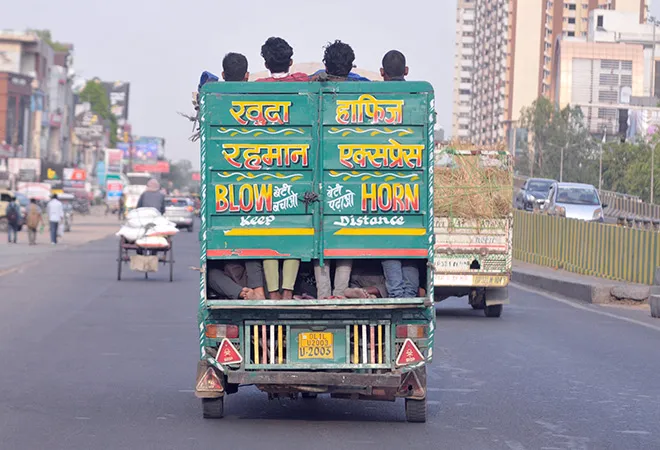
On 28 June, the Supreme Court (SC) delivered a significant judgment in dealing with the plight of migrant labourers during the second wave of the COVID-19 pandemic. Taking suo motu cognizance of the delay in implementation of “One Nation One Card” scheme depriving millions of migrant workers critical access to welfare measures, the SC called this the government’s “apathy and lackadaisical attitude” towards creating a national database for unorganised workers. The bench directed states that had not yet compiled the database to complete the task by 31 July 2021. It may be recalled that the Supreme Court in its previous order in May 2020 had directed the Union Ministry of Labour and Employment to announce the establishment of a National Database of Unorganised Workers (NDUW).
It needs to be mentioned that on 24 March last year, India had imposed a nationwide lockdown — amongst the strictest in the world — to prevent the spread of the COVID-19 pandemic. With businesses at a standstill and public transport shut down, thousands of migrant workers were left stranded, furloughed or unemployed. They began to walk and cycle on highways for hundreds of kilometres, as the pandemic raged, to reach their homes and families, hazarding their lives in the process — up to 26.4 percent of total road accident deaths during the national lockdown were migrant workers journeying home.
The fact of the matter is that the day before the lockdown was announced, the Ministry of Labour and Employment revealed that “No (migrant worker) register (is) maintained.”
According to official estimates, over 11.4 million migrant workers returned to their home states — a figure that underrepresents the true scale of the exodus since it only accounts for workers who returned via public transport (once services resumed) and not those who returned by foot. The fact of the matter is that the day before the lockdown was announced, the Ministry of Labour and Employment revealed that “No (migrant worker) register (is) maintained.” Moreover, data recorded regarding migrant workers is outdated: The Ministry estimated, from 2011 census data, that the migrant workforce was as large as 100 million in 2016 — a number that is bound to have been greater in 2020.
The most recent National Sample Survey on migration was conducted over a decade ago in 2007-08 and published in 2010. Even the 2011 census information regarding migration is lacking since only incomplete data on the subject was released as late as 2020. According to the Economic Survey of 2020-21, “With limited data available on inter-state migration and employment in informal sectors, it is difficult to figure the numbers of migrants who lost jobs and accommodation during the pandemic and returned home.”
Even the 2011 census information regarding migration is lacking since only incomplete data on the subject was released as late as 2020.
Imperative of a robust national database
In such a context, the need for updated information on migrant workers, their demographic characteristics, income and consumption levels, and accessibility to social security measures cannot be overstated to mount any major national intervention. A robust database at the national and state levels is paramount to the creation of relevant policy design. From initiating schemes to aid migrant workers to deciding on budget allocations, information is integral to the development of effective state responses. In fact, an International Labour Organisation report on migrant workers in India emphasises the role of data in fostering effective interventions for public welfare — “The interface between migrant workers and public systems and services can be established only if there are reliable databases at all levels of governance.”
The National Database is envisioned to be a dynamic portal wherein workers can self-enrol themselves, or attend local common service centres to be registered, in the Aadhar-linked programme to be brought within the ambit of welfare schemes. The Labour Bureau also announced in December 2020 that it will conduct five pan-India surveys, including an All-India Survey of Migrant Workers, that is estimated to be completed by October 2021.
Unexplained delays
The compelling need to establish a database of unorganised workers has been iterated even before the pandemic — the Supreme Court directed the government to record workers’ data as far back as 2018, while the 2017 Report of the Working Group on Migration recommended that data on the subject should be generated and tabulated, and it necessitated the need for information regarding “district to district flows of migration,” and emphasised that existing data must be released to the public domain. Even the Unorganised Sector Workers’ Social Security Act, 2008, has provisions for a database of unorganised workers.
However, despite the fact that over INR 4 billion has been disbursed for the project, the National Database of Unorganised Workers is yet to be completed. The reasons, according to the government, leading up to the current state of data paucity are two-fold: Firstly, the fact that migrants move across states extensively and shift sectors regularly render data collection unfeasible. Secondly, the development of the National Database of Unorganised Workers is unfinished because the second wave of the pandemic has disrupted work, while coordination with state governments is taking longer than expected, resulting in a failure to meet the expected completion date of June 2021.
In the face of these delays, the benefits of a speedy completion of the database to migrant workers must be emphasised. A National Database is the “first step” in including migrant workers in social security measures under the Code on Social Security, 2020, a legislation that combines eight labour laws to extend social security to all workers, even those in the unorganised sector — estimated to be as large as 380 million, of which migrant workers number between two and three million. More immediately, the database is important to include migrant workers in COVID-19-related welfare schemes. The coverage of the population under the National Food Security Act 2013, for instance, is based on the Planning Commission’s 2011-12 household consumption survey data which excludes an estimated 80 million migrant workers — a statistic that, due to a lack of data, is simply a guess. Despite the government’s promise to provide five kilograms of food grains and one kilogram of pulses to these workers in May and June 2020, the lack of an existing database has resulted in complications in identifying beneficiaries, resulting in only 22.4 and 22.5 million of the 80 million migrant workers receiving food assistance in the two months.
Additionally, data on the socioeconomic contexts of migrant workers can augment policymakers’ efforts to address barriers in accessing welfare provisions such as the PDS and cash transfers, helping those who are bearing the brunt of the consequences of the pandemic; according to a survey of 11,000 migrant workers, 96 percent did not receive any government rations, 89 percent were left unpaid during the lockdown, and 50 percent did not have sufficient food to last for more than a day. In fact, cash transfers for migrant workers were not a component of government relief measures since workers’ Aadhar and bank account details are unknown. Furthermore, disaggregated data encompassing rural and urban inter- and intra- state migrant workers will help prepare the government for an impending third wave of COVID-19, especially since reverse migration arises when there are expectations of lockdowns — during the second wave, in Delhi alone, 807,032 migrant workers left the city between April and May 2021.
Conclusion
As explained above, a comprehensive database is vital to alleviate the distress of a quarter of the country’s population, especially in the context of the current public health emergency. The largescale exodus of migrant workers from urban regions of the country underscores the immediacy of the need for updated information. Census and National Sample Service data that is over a decade old does not reflect the present conditions of the low-skilled, informal migrant workers who are excluded from critical social security measures. Heeding to the SC’s directions in 2018 and its more recent instructions to complete the National Database of Unorganised Workers portal by 31 July 2021 is crucial to mount effective policies and inclusive welfare measures. Publicly available updated and disaggregated statistics is integral to public service delivery, from providing assistance in food security under the NFSA by mitigating targeting errors and initiating cash transfers to augment incomes through bank account and Aaadhar details to preparing for a potentially devastating third wave of the COVID-19 pandemic.
Keerthana Chavaly is a Research Intern at ORF.
The views expressed above belong to the author(s). ORF research and analyses now available on Telegram! Click here to access our curated content — blogs, longforms and interviews.




 PREV
PREV

